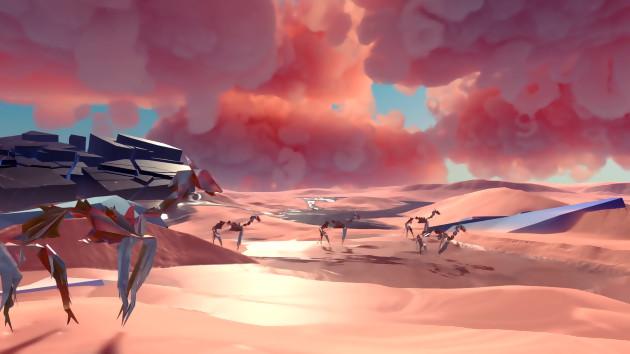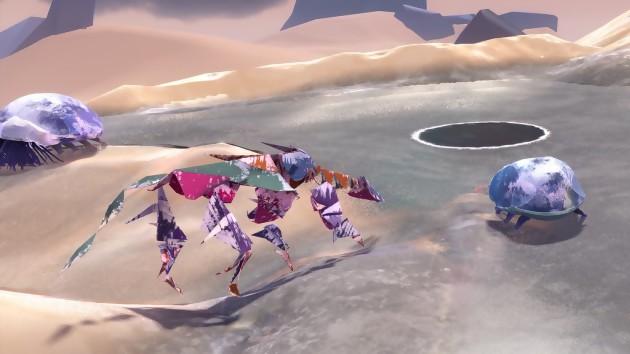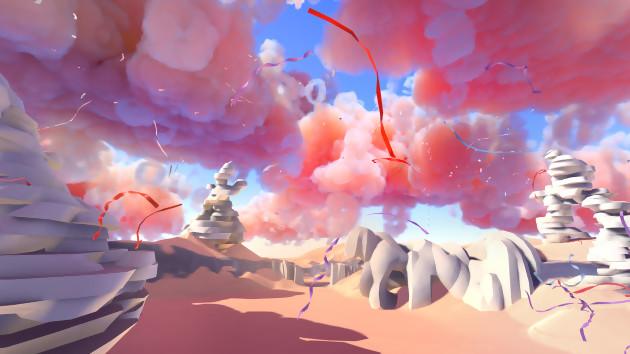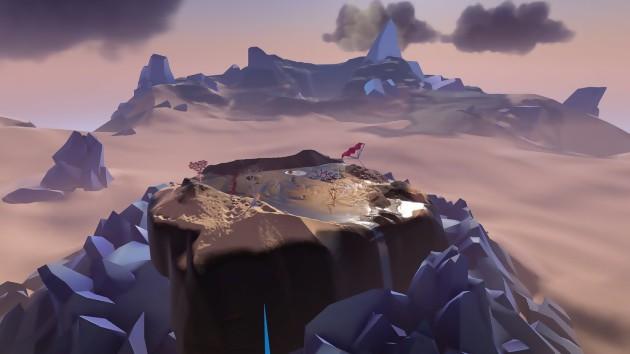 From the first moments, Paper Beast is confusing. A computer interface followed by a “SwirlyBeat” music application, before proceeding to raise the curtain yourself using the DualShock 4 or PlayStation Move: as an introduction, it's anything but classic. Looking up, we realize that a huge creature (sorry, entity) is watching us with palpable curiosity. Not an indicator, not a map, not an instruction, not a sound – except that of the wind which sweeps the sand of the great desert expanse where we find ourselves. We are lost in the middle of nowhere, and this is precisely the effect sought by Pixel Reef which, at no time during the game, will take our hand. Observing the world around us and understanding its ecosystem will be the keys to progressing through the seven chapters (each divided into three levels) that Paper Beast contains. Moreover, while the first entity moves away, a second one of tiny size passes under our eyes; we then realize that we can grasp it to better examine it from all angles. The color code of our pointer is quite easy to assimilate: yellow for elements that can be moved, red for those that cannot be moved, and blue for those that can be associated with others. After the effect of the discovery, we dare to venture a little further, the developers having opted for teleportation in order (probably) to limit the unpleasant effects of motion sickness. It works perfectly, and even when we hurry, the brain and the stomach hold the shock.
From the first moments, Paper Beast is confusing. A computer interface followed by a “SwirlyBeat” music application, before proceeding to raise the curtain yourself using the DualShock 4 or PlayStation Move: as an introduction, it's anything but classic. Looking up, we realize that a huge creature (sorry, entity) is watching us with palpable curiosity. Not an indicator, not a map, not an instruction, not a sound – except that of the wind which sweeps the sand of the great desert expanse where we find ourselves. We are lost in the middle of nowhere, and this is precisely the effect sought by Pixel Reef which, at no time during the game, will take our hand. Observing the world around us and understanding its ecosystem will be the keys to progressing through the seven chapters (each divided into three levels) that Paper Beast contains. Moreover, while the first entity moves away, a second one of tiny size passes under our eyes; we then realize that we can grasp it to better examine it from all angles. The color code of our pointer is quite easy to assimilate: yellow for elements that can be moved, red for those that cannot be moved, and blue for those that can be associated with others. After the effect of the discovery, we dare to venture a little further, the developers having opted for teleportation in order (probably) to limit the unpleasant effects of motion sickness. It works perfectly, and even when we hurry, the brain and the stomach hold the shock.
Far from being a killer app, far from being perfect, Paper Beast on the other hand offers a dreamlike world like no other, and leaves the player freedom of action and deduction until upsetting his bearings.
 If we spoke of an ecosystem a little higher, it is quite simply because different organisms coexist in the game. Just look at how the Papyvorus act when you hand them a ball of paper, to understand that the fauna and flora are intimately linked. By scrutinizing the other entities, we notice that they all have their own behavior. For example, Pushers build their nest by accumulating balls of sand, while Pullers uproot plants. There are also the Sanders who form heaps of sand on the water, without forgetting the Predators and the Voraxo ready to devour anything that moves. Animals are not the only ones to have been the subject of very special care (not to say obsessive), Pixel Reef having also endeavored to respect certain natural phenomena. Thus, the Radiant will melt a block of ice, unlike the Freeze which will freeze the water. As in From Dust, erosion also has its say, and since the water is capricious at times, it is best to handle the sand with precision so as not to be taken aback by the current. Speaking of water, two puzzles blew us away in how they handle its physics; we leave you the surprise. Finally, we can also mention the wind which is entitled to its quarter of an hour of glory: with origami as stars, the occasion was too good. Unusual in other productions, these interactions become exhilarating here, since each of our findings is a potential solution to the equations submitted by Paper Beast.
If we spoke of an ecosystem a little higher, it is quite simply because different organisms coexist in the game. Just look at how the Papyvorus act when you hand them a ball of paper, to understand that the fauna and flora are intimately linked. By scrutinizing the other entities, we notice that they all have their own behavior. For example, Pushers build their nest by accumulating balls of sand, while Pullers uproot plants. There are also the Sanders who form heaps of sand on the water, without forgetting the Predators and the Voraxo ready to devour anything that moves. Animals are not the only ones to have been the subject of very special care (not to say obsessive), Pixel Reef having also endeavored to respect certain natural phenomena. Thus, the Radiant will melt a block of ice, unlike the Freeze which will freeze the water. As in From Dust, erosion also has its say, and since the water is capricious at times, it is best to handle the sand with precision so as not to be taken aback by the current. Speaking of water, two puzzles blew us away in how they handle its physics; we leave you the surprise. Finally, we can also mention the wind which is entitled to its quarter of an hour of glory: with origami as stars, the occasion was too good. Unusual in other productions, these interactions become exhilarating here, since each of our findings is a potential solution to the equations submitted by Paper Beast.
SHEET OF PAPER
 Let the less resourceful be reassured: none is insoluble. Most of the elements, which we need to conduct our thinking, are often placed under our noses; and in case, teleporters located in height allow to have a better overview. In return for this ease which sometimes serves the game, the developers have not integrated any help, any clue likely to put on the way. On the other hand, it would have been in total contradiction with this desire to take the player out of his comfort zone. Despite everything, we can blame Paper Beast for a lack of regularity in its puzzles when it is still one of the main components of the title. More concretely, between two well-thought-out puzzles, we come across a few riddles that we quickly clear up. This lack of inspiration not only reinforces the redundancy of the game, but also makes it seem like the developers have given in to filler. Honestly, there are puzzles that are absolutely useless, and it would probably have been wiser to skip them in favor of passages solely dedicated to contemplation. Because despite the graphic limits inherent in virtual reality, Paper Beast is a painting that we never tire of looking at. We could compare it to those imaginary worlds that we dream of and hope to find the following night. If the charm already operates when the sky is clear and the sun is beating down, the refined artistic direction takes on a whole new dimension as soon as the weather darkens.
Let the less resourceful be reassured: none is insoluble. Most of the elements, which we need to conduct our thinking, are often placed under our noses; and in case, teleporters located in height allow to have a better overview. In return for this ease which sometimes serves the game, the developers have not integrated any help, any clue likely to put on the way. On the other hand, it would have been in total contradiction with this desire to take the player out of his comfort zone. Despite everything, we can blame Paper Beast for a lack of regularity in its puzzles when it is still one of the main components of the title. More concretely, between two well-thought-out puzzles, we come across a few riddles that we quickly clear up. This lack of inspiration not only reinforces the redundancy of the game, but also makes it seem like the developers have given in to filler. Honestly, there are puzzles that are absolutely useless, and it would probably have been wiser to skip them in favor of passages solely dedicated to contemplation. Because despite the graphic limits inherent in virtual reality, Paper Beast is a painting that we never tire of looking at. We could compare it to those imaginary worlds that we dream of and hope to find the following night. If the charm already operates when the sky is clear and the sun is beating down, the refined artistic direction takes on a whole new dimension as soon as the weather darkens.
More concretely, between two well-thought-out puzzles, we come across a few riddles that we quickly clear up. This lack of inspiration not only reinforces the redundancy of the game, but also makes it seem like the developers have given in to filler.
 We don't necessarily think of gusts of wind or figures that think they are clouds, we rather refer to twilight and its colors imbued with lyricism. Although we get a glimpse of it while crossing the caves, it is only in the open air that everything explodes in the face. The icing on the cake: the sublime soundtrack that knows how to be discreet when necessary, as if not to take the risk of interrupting the immersion so dear to Eric Chahi. Paper Beast is also a "Sandbox" mode where the player can create their own levels using different tools, knowing that some (animals, objects, plants, among others) will have to be unlocked via the main campaign. . The ideal time to better understand certain behaviors that would not have jumped out at us - even if we quickly go around them - like reproduction or the impact of the weather on entities. Note that a gauge determines the number of elements that a map can contain, and that there is a way to save up to eight creations. In terms of ergonomics, it's not crazy, which also makes it possible to highlight the concerns of precision when the animals are superimposed in front of an object that one wishes to move. Nothing particularly prohibitive, that said.
We don't necessarily think of gusts of wind or figures that think they are clouds, we rather refer to twilight and its colors imbued with lyricism. Although we get a glimpse of it while crossing the caves, it is only in the open air that everything explodes in the face. The icing on the cake: the sublime soundtrack that knows how to be discreet when necessary, as if not to take the risk of interrupting the immersion so dear to Eric Chahi. Paper Beast is also a "Sandbox" mode where the player can create their own levels using different tools, knowing that some (animals, objects, plants, among others) will have to be unlocked via the main campaign. . The ideal time to better understand certain behaviors that would not have jumped out at us - even if we quickly go around them - like reproduction or the impact of the weather on entities. Note that a gauge determines the number of elements that a map can contain, and that there is a way to save up to eight creations. In terms of ergonomics, it's not crazy, which also makes it possible to highlight the concerns of precision when the animals are superimposed in front of an object that one wishes to move. Nothing particularly prohibitive, that said.


























